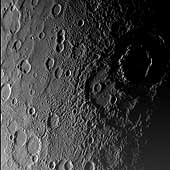|
COMETS EARTH JUPITER KUIPER BELT MARS MERCURY METEORITES NEPTUNE OORT CLOUD PLUTO SATURN SOLAR SYSTEM SPACE SUN URANUS VENUS ORDER PRINTS
PHOTO CATEGORIES SCIENCEVIEWS AMERICAN INDIAN AMPHIBIANS BIRDS BUGS FINE ART FOSSILS THE ISLANDS HISTORICAL PHOTOS MAMMALS OTHER PARKS PLANTS RELIGIOUS REPTILES SCIENCEVIEWS PRINTS
|
Related Documents
Download Options
As MESSENGER approached Mercury on January 14, 2008, the spacecraft's Narrow-Angle Camera on the Mercury Dual Imaging System (MDIS) instrument captured this view of the planet's rugged, cratered landscape illuminated obliquely by the Sun. The large, shadow-filled, double ringed crater to the upper right was glimpsed by Mariner 10 more than three decades ago and named Vivaldi, after the Italian composer. Its outer ring has a diameter of about 200 kilometers (about 125 miles). MESSENGER's modern camera has revealed detail that was not well seen by Mariner 10, including the broad ancient depression overlapped by the lower-left part of the Vivaldi crater. The MESSENGER science team is in the process of evaluating later images snapped from even closer range showing features on the side of Mercury never seen by Mariner 10. It is already clear that MESSENGER's superior camera will tell us much that could not be resolved even on the side of Mercury viewed by Mariner's vidicon camera in the mid-1970s. This MESSENGER image was taken from a distance of about18,000 kilometers (11,000 miles), about 56 minutes before the spacecraft's closest encounter with Mercury. It shows a region roughly 500 kilometers (300 miles) across, and craters as small as 1 kilometer (0.6 mile) can be seen in this image. Credit: NASA/Johns Hopkins University Applied Physics Laboratory/Carnegie Institution of Washington |
